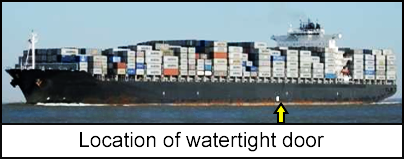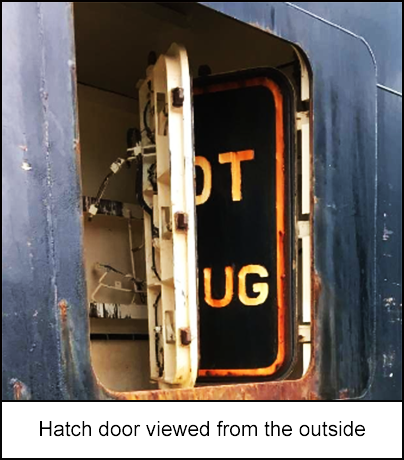-
What happened?
A large container ship (330m/1100ft) arrived in port in bad weather (40 knot winds and 4m swell).
The ship was being manoeuvred so that a pilot could embark at a port side hatch.
Two crewmen were preparing for the pilot’s arrival behind the hydraulically operated bi-fold hatch door.
The vessel was hit by heavy seas that forced the hatch door open.
The water flooded the embarkation space, sweeping one crewman out to sea and injuring another.
The crewman washed out to sea was presumed dead after 28 hours of searching.
The injured crewman suffered a broken leg when the pilot ladder fell on him.
The hatch door itself was also damaged.

-
Why did it happen?
Combined risk factors:
- The crew’s inability to observe and assess the sea conditions from their position behind the hatch doors.
- Ship’s roll and sea state - bad weather struck and violently forced the hatch door open.
The crewman that died was not wearing a harness/safety line, nor a personal flotation device when they were washed overboard.

-
What did they learn?
Take great care with personnel transfer at sea, especially in heavy weather conditions.
Officers and crew should identify potential hazards and conduct risk assessments before opening hatch doors.
Reinforce the importance of wearing personal protection devices and safety lines.
Ensure communications between navigation watch officers and crew are clear.
Provide suitable supervision of activities, considering sea state and other changing conditions.
Review and update vessel safety management systems (SMS), procedural manuals and guidance that relates to pilot transfers.

-
Ask yourself or your crew
What are your procedures for pilot transfers?
- Do they change when dealing with bad weather?
- What extra risk assessments should you carry out before opening hatch doors?
What should you do if you see colleagues working without appropriate PPE?
What measures do we have in place for preventing this happening here? How can we improve?

Add to homescreen
Content name
Select existing category:
Content name
New collection
Edit collection
What happened?
A large container ship (330m/1100ft) arrived in port in bad weather (40 knot winds and 4m swell).
The ship was being manoeuvred so that a pilot could embark at a port side hatch.
Two crewmen were preparing for the pilot’s arrival behind the hydraulically operated bi-fold hatch door.
The vessel was hit by heavy seas that forced the hatch door open.
The water flooded the embarkation space, sweeping one crewman out to sea and injuring another.
The crewman washed out to sea was presumed dead after 28 hours of searching.
The injured crewman suffered a broken leg when the pilot ladder fell on him.
The hatch door itself was also damaged.

Why did it happen?
Combined risk factors:
- The crew’s inability to observe and assess the sea conditions from their position behind the hatch doors.
- Ship’s roll and sea state - bad weather struck and violently forced the hatch door open.
The crewman that died was not wearing a harness/safety line, nor a personal flotation device when they were washed overboard.

What did they learn?
Take great care with personnel transfer at sea, especially in heavy weather conditions.
Officers and crew should identify potential hazards and conduct risk assessments before opening hatch doors.
Reinforce the importance of wearing personal protection devices and safety lines.
Ensure communications between navigation watch officers and crew are clear.
Provide suitable supervision of activities, considering sea state and other changing conditions.
Review and update vessel safety management systems (SMS), procedural manuals and guidance that relates to pilot transfers.
Ask yourself or your crew
What are your procedures for pilot transfers?
- Do they change when dealing with bad weather?
- What extra risk assessments should you carry out before opening hatch doors?
What should you do if you see colleagues working without appropriate PPE?
What measures do we have in place for preventing this happening here? How can we improve?
A container ship arrived in port in bad weather. The heavy seas forced a hatch door open, washing one crewman out to sea, and injuring another.













